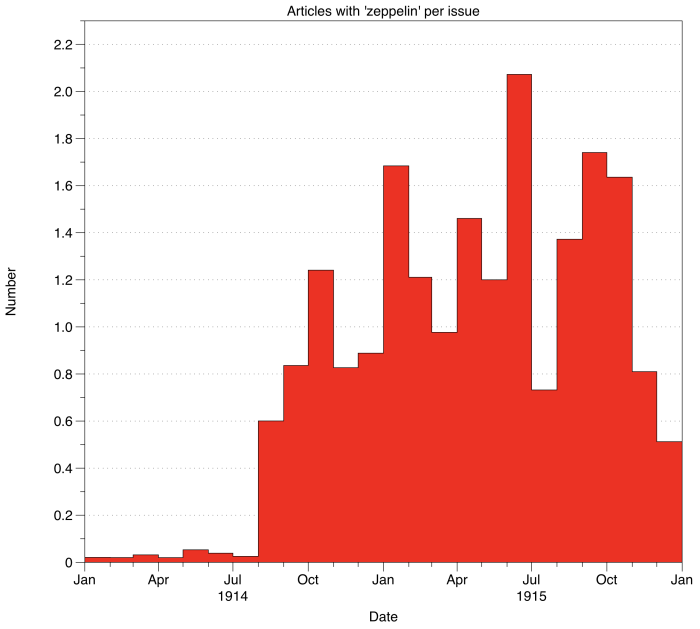So I half-promised a final post in this series about the airship panic of 1915. There are a couple of methodological points I’d like to make.
The first point is that this is an unusually well-attested panic. There are panics with more sources, but not with so many different kinds of sources. Here, there are three overlapping and fairly consistent layers of evidence for phantom airship sightings or rumours of air raids: stories in the press; military intelligence reports and analyses; and private diaries and letters. For peacetime panics, newspapers are normally the only source of information, with scant evidence for official interest — for example, the 1913 phantom airship panic. In wartime, there is much more in the way of intelligence interest, but less full and/or less frank press coverage, partly due to censorship — for example, the 1918 mystery aeroplane panic in Australia and New Zealand. In both peace and war, presumably private individuals wrote in letters and diaries about the mystery aircraft they saw or heard about, but they’re hard to survey on any scale, inevitably hit and miss, and in any case I don’t think anyone else has looked.
The second point relates to the usefulness of my distant reading method for finding and defining panics through the British Newspaper Archive. It seems to work in practice, but I’m not sure that it works in theory. What I ended up doing was looking for periods when the number of articles containing both the word ‘zeppelin’ and the word ‘rumour’ peaked. With this method I identified two likely periods for a Zeppelin panic in the period November 1914 through February 1915, namely from late December through mid-January, and then late January through early February. And these periods do roughly correspond with phantom airship sightings and other false alarms found using close reading, not only in newspapers but also in government and private archival sources. But there are many problems with this technique. One is that I’ve just assumed that newspapers would use the term ‘rumour’ when talking about phantom airships — but if their source seems impeccable, or the account brief, then why would they? Another is that I ought to have carried out a more comprehensive search with cognate terms such as ‘airship’ or ‘scare’. Yet another is structural: BNA doesn’t always detect separate articles very well, with the result that a rumour from the front in France, say, might appear to be associated with a story about real Zeppelin operations. I suppose these kind of issues are always going to occur with distant reading — part of the point is that you are stepping back and looking at the big picture; conversely you still need to go on to do close reading. I guess I’m just surprised that my first try seems to have worked so well, at least as far as finding Zeppelin panics goes.
One particular aspect I’ll expand upon here is the question of Sundays. Relative to other days of the week, BNA has very few Sunday newspapers for late 1914/early 1915 — only 1 or 2. Presumably this is because there were fewer Sunday newspapers full stop. But this is a problem, because I normalise the data — that is I divide the number of keyword hits by the number of issues to try to account for the incompleteness of BNA’s coverage (which is not always the right way to go, but because I’m looking for a panic signal I think it’s appropriate here). On most Sundays, there are no articles with both ‘zeppelin’ and ‘rumour’, which, however it is normalised, remains 0. But sometimes there is one article. And because there are only one or two issues, that means the normalised number is 0.5 or even 1.0, which in this dataset is a significant spike. In fact it means that Sunday, 10 January 1915, is the biggest spike of all, despite having only 2 articles with the words ‘zeppelin’ and ‘rumour’. For comparison, the highest absolute number of hits is on 20 January (a Wednesday), with 35 hits, which is normalised to 0.8. So the Sundays could be giving spurious signals; 10 January is right in one of the periods I identified above.
There are a couple of simple ways to get around this. One is to massage the data by simply taking out the Sundays. But this itself is skewing the data, however it’s done. So instead I’ll just apply smoothing through a moving average over 7 days (since this is the natural periodicity in newspaper publication dates). This isn’t perfect either, but it reduces the effects of anomalous Sundays and other fluctuations in the data, while retaining the longer term trends.
So here, the previous plot is in red, and the smoothed data is in black. There is still a peak in early January; after all the Sunday in question is not the only contributor. But at least it’s smaller than the late January one, which from the close reading would appear to be correct. I think this is better.
That’s all I have to say on the airship panic of 1915 for the moment. But having done all this work I probably should do something with it!
![]() This work is licensed under a Creative Commons Attribution-NonCommercial-NoDerivatives 4.0 International License.
Permissions beyond the scope of this license may be available at http://airminded.org/copyright/.
This work is licensed under a Creative Commons Attribution-NonCommercial-NoDerivatives 4.0 International License.
Permissions beyond the scope of this license may be available at http://airminded.org/copyright/.




